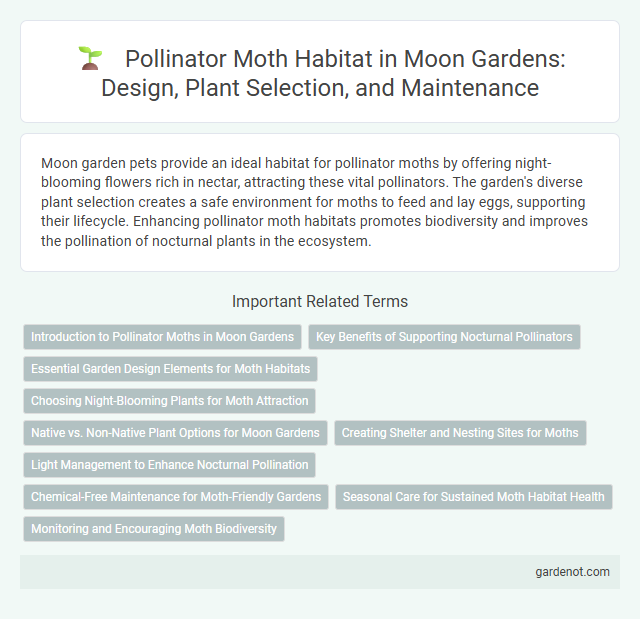Moon garden pets provide an ideal habitat for pollinator moths by offering night-blooming flowers rich in nectar, attracting these vital pollinators. The garden's diverse plant selection creates a safe environment for moths to feed and lay eggs, supporting their lifecycle. Enhancing pollinator moth habitats promotes biodiversity and improves the pollination of nocturnal plants in the ecosystem.
Introduction to Pollinator Moths in Moon Gardens
Pollinator moths play a vital role in moon gardens by facilitating nighttime pollination for various nocturnal flowering plants like evening primrose and jasmine. These moths are attracted to pale, fragrant blooms that emit strong scents at dusk, enhancing their visibility and scent detection. Creating a habitat with native plants, minimal artificial lighting, and suitable shelter supports healthy pollinator moth populations, ensuring effective pollination and vibrant garden ecosystems.
Key Benefits of Supporting Nocturnal Pollinators
Supporting nocturnal pollinators like moths in a moon garden enhances biodiversity by promoting the reproduction of native night-blooming plants. These moths contribute to the pollination of many species that diurnal pollinators often overlook, ensuring ecosystem resilience and plant genetic diversity. Providing a dedicated habitat for pollinator moths helps maintain balanced food webs and supports the survival of other nocturnal wildlife.
Essential Garden Design Elements for Moth Habitats
Pollinator moth habitats thrive in moon gardens designed with key elements such as night-blooming flowers, which provide nectar during moth activity hours. Incorporating native plant species that emit strong, sweet fragrances at dusk attracts moths essential for pollination. Features like sheltered areas and moisture sources support moth life cycles, enhancing biodiversity and garden health.
Choosing Night-Blooming Plants for Moth Attraction
Selecting night-blooming plants like moonflowers, evening primroses, and nicotianas creates ideal habitats for pollinator moths in moon gardens. These plants emit strong fragrances and release nectar during nighttime, attracting moth species essential for pollination. Incorporating native night-blooming flora enhances biodiversity and supports local moth populations effectively.
Native vs. Non-Native Plant Options for Moon Gardens
Native plants in moon gardens provide essential habitats for pollinator moths, offering the right nectar sources and nocturnal shelter that support local moth species' life cycles. Non-native plants often lack the chemical cues and structural features needed by these moths, leading to reduced pollination efficiency and biodiversity. Prioritizing native plant options enhances the ecological balance and promotes a thriving pollinator moth population in moon garden ecosystems.
Creating Shelter and Nesting Sites for Moths
Moon gardens provide essential shelter and nesting sites for pollinator moths by incorporating dense, native shrubs and night-blooming plants that offer protection and feeding opportunities. Structures such as hollow stems, leaf litter, and soft soil patches create ideal microhabitats for moth larvae to develop safely. Enhancing habitat complexity with natural materials supports moth population growth and promotes nocturnal pollination crucial for moon garden ecosystem health.
Light Management to Enhance Nocturnal Pollination
Effective light management in moon gardens significantly enhances nocturnal pollination by creating an optimal environment for pollinator moths, whose activity peaks during low-light conditions. Minimizing artificial light pollution with warm, dim lighting preserves moth navigation and foraging behaviors, essential for transferring pollen in night-blooming plants such as evening primrose and moonflower. Incorporating shielded, motion-activated lights further reduces disruption, promoting thriving moth habitats and boosting biodiversity in nocturnal ecosystems.
Chemical-Free Maintenance for Moth-Friendly Gardens
Chemical-free maintenance in moon gardens promotes a thriving pollinator moth habitat by eliminating harmful pesticides and synthetic fertilizers. Native plants and organic mulches support moth lifecycle stages, ensuring food and shelter availability. Emphasizing natural pest control methods enhances biodiversity and sustains moth populations essential for nighttime pollination.
Seasonal Care for Sustained Moth Habitat Health
Seasonal care in a moon garden enhances pollinator moth habitat health by providing year-round nectar sources and host plants specific to moth species. Regular pruning of native flora and avoiding pesticides ensures a safe environment for moth larvae and adults during breeding cycles. Monitoring moisture levels and planting night-blooming flowers support nocturnal feeding behaviors crucial for sustained moth populations.
Monitoring and Encouraging Moth Biodiversity
Regular monitoring of pollinator moths in Moon gardens involves using light traps and visual surveys to track species diversity and population health. Planting native night-blooming flowers like evening primrose and tobacco ensures continual nectar sources, supporting moth breeding and feeding. Enhancing habitat complexity with leaf litter and undisturbed soil provides essential shelter for larvae and pupae, promoting sustainable moth biodiversity.
Pollinator moth habitat Infographic

 gardenot.com
gardenot.com